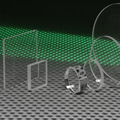Synthetic Quartz that is used in microelectronics is produced in an autoclave via the hydrothermal process. Our Synthetic Quartz is then polished into transparent quartz glass substrates with an ultra-high purity and improved optical transmission in the deep ultraviolet.
Applications of Synthetic Quartz Glass Substrates include photomask substrates in the semiconductor industry, poly-Si-TFT substrates for LCDs, micro lens substrates
for LCDs and fiber optics, substrates for high frequency (RF) applications, microfluidic substrates, Nano-Imprint Templates, and DNA chip substrates.
Click here to download Synthetic Quartz Glass Substrates DatasheetS-Grade Synthetic Quartz Glass Substrates feature Ra<2A surface quality (Double Side Typ.) per semiconductor standard.
Features of Synthetic Quartz Glass Substrates include:
Purity: High purity levels eliminates contamination in the quartz substrates.
Chemical resistance: Excellent thermal shock resistance and quartz glass is chemically inert to most elements and compounds including virtually all acids.
Heat resistance: High dimensional stability of the quartz glass over a wide temperature range with extremely low coefficient of thermal expansion.
Transparency: Quartz glass allow a high transmission over a wide range of wavelengths from UV to IR.
Fluorescence: No fluorescence over a wide range of wavelengths from UV to IR.
Dielectric properties: Low dielectric loss even at GHz frequencies.
Surface: High flatness, high uniformity of thickness and smooth surfaces, attributed to the techniques developed for quartz glass photomask substrates used in LSI manufacturing.








